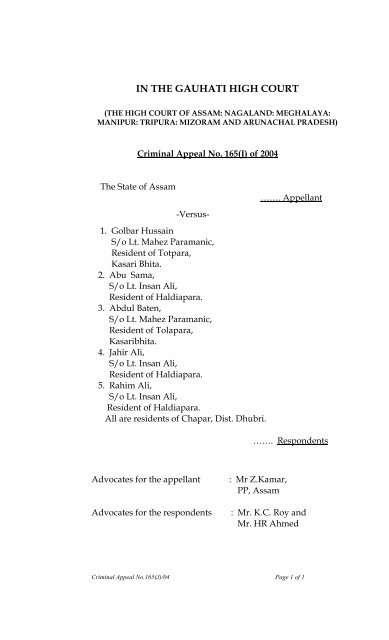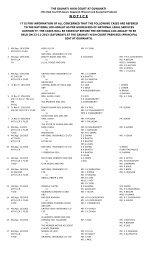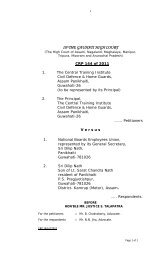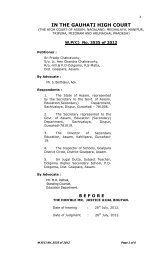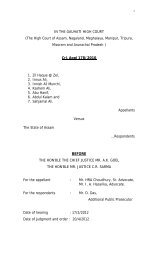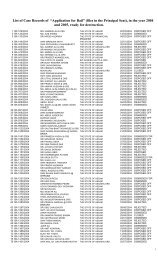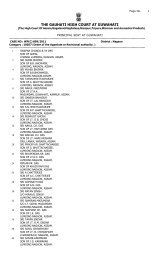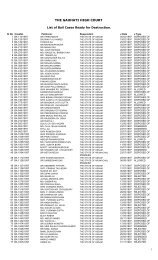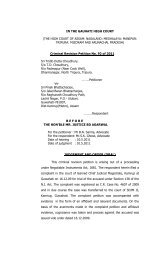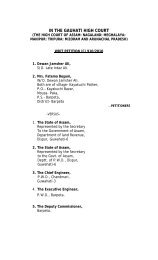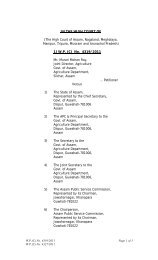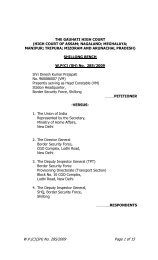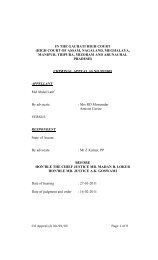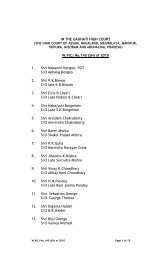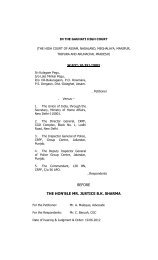Crl.A(J) 165/2004 - Gauhati High Court
Crl.A(J) 165/2004 - Gauhati High Court
Crl.A(J) 165/2004 - Gauhati High Court
Create successful ePaper yourself
Turn your PDF publications into a flip-book with our unique Google optimized e-Paper software.
IN THE GAUHATI HIGH COURT<br />
(THE HIGH COURT OF ASSAM: NAGALAND: MEGHALAYA:<br />
MANIPUR: TRIPURA: MIZORAM AND ARUNACHAL PRADESH)<br />
Criminal Appeal No. <strong>165</strong>(J) of <strong>2004</strong><br />
The State of Assam<br />
-Versus-<br />
1. Golbar Hussain<br />
S/o Lt. Mahez Paramanic,<br />
Resident of Totpara,<br />
Kasari Bhita.<br />
2. Abu Sama,<br />
S/o Lt. Insan Ali,<br />
Resident of Haldiapara.<br />
3. Abdul Baten,<br />
S/o Lt. Mahez Paramanic,<br />
Resident of Tolapara,<br />
Kasaribhita.<br />
4. Jahir Ali,<br />
S/o Lt. Insan Ali,<br />
Resident of Haldiapara.<br />
5. Rahim Ali,<br />
S/o Lt. Insan Ali,<br />
Resident of Haldiapara.<br />
All are residents of Chapar, Dist. Dhubri.<br />
……. Appellant<br />
……. Respondents<br />
Advocates for the appellant<br />
Advocates for the respondents<br />
: Mr Z.Kamar,<br />
PP, Assam<br />
: Mr. K.C. Roy and<br />
Mr. HR Ahmed<br />
Criminal Appeal No.<strong>165</strong>(J)/04 Page 1 of 1
PRESENT<br />
THE HON’BLE CHIEF JUSTICE MR. AK GOEL<br />
HON’BLE MR. JUSTICE B D AGARWAL<br />
Date of hearing : 9.08.2012<br />
Date of Judgment : 31.08.2012<br />
JUDGEMENT AND ORDER (CAV)<br />
B D Agarwal, J.<br />
This appeal under Section 370 of the Code of Criminal<br />
Procedure has been filed by the State challenging the judgment<br />
and order dated 29.7.2003 passed by the learned Sessions<br />
Judge, Dhubri in Sessions Case No. 20 of 2002 whereby the<br />
learned Sessions Judge has acquitted all the five accused<br />
persons from the offence of murder by forming an unlawful<br />
assembly.<br />
2. We have heard Mr. Z. Kamar, learned Public Prosecutor<br />
for the State as well as Mr. K.C. Roy, learned counsel appearing<br />
for the accused persons/respondents. Sri HR Ahmed, learned<br />
counsel appeared for the informant and he was also heard. We<br />
have also gone through the impugned judgment and the<br />
evidence proffered by the prosecution in the trial court.<br />
3. The defence case was of total denial. Though the accused<br />
persons were residing in the nearby village under the same<br />
police station of the deceased and the deceased was wellknown<br />
to the accused persons they have expressed their<br />
ignorance about the murder of Hasen Ali and all the five<br />
Criminal Appeal No.<strong>165</strong>(J)/04 Page 2 of 2
accused persons took the plea of total denial and no evidence in<br />
defence was tendered in the trial court.<br />
4. The offence of murder took place at about 6.00 PM on<br />
5.1.2001 by the side of a public road. At the relevant time, the<br />
deceased was returning home from Chapar market along with<br />
PWs 4 and 5 and on the way the accused persons suddenly<br />
appeared at the scene from all the four sides and attacked the<br />
deceased with various kinds of sharp and pointed weapons and<br />
hacked him to death.<br />
5. The FIR was lodged by the son of the deceased on the<br />
very same day narrating the aforesaid story and also<br />
specifically naming five accused persons in the crime. The FIR<br />
was registered as Chapor Police Station Case No.3 of 2001<br />
under Sections 147/148/149/341/302 of the Indian Penal Code.<br />
The case was investigated by Sub-Inspector, Sri S.C. Biswas<br />
(PW 9). The Investigating Officer has confirmed in his<br />
testimony that initially the information of murder was received<br />
from the informant at 6.15 PM. From the printed form of the<br />
FIR it is gathered that the written FIR was lodged at 10.00 PM<br />
i.e., within four hours of the incident. After the charge-sheet,<br />
the accused persons were tried only for the offence under<br />
Section 302 read with Section 149 of the Indian Penal Code and<br />
after the trial all the five accused persons have been acquitted.<br />
Hence, this appeal at the instance of the State.<br />
6. Before venturing to examine the legality and correctness<br />
of the impugned judgment as well as appreciating the<br />
prosecution evidence, it would be just and proper to have a<br />
Criminal Appeal No.<strong>165</strong>(J)/04 Page 3 of 3
ief look about the legal position of an appeal against<br />
acquittal. Adverting to various authorities, the Hon’ble<br />
Supreme <strong>Court</strong> in the case of Chandrappa and Ors –Vs- State<br />
of Karnataka; reported in (2007) 4 SCC 415 : 2007 CriLJ 2136<br />
has culled out the following legal principles:<br />
“30. From the above decisions, in our considered<br />
view, the following general principles regarding<br />
powers of appellate <strong>Court</strong> while dealing with an<br />
appeal against an order of acquittal emerge;<br />
(1) An appellate <strong>Court</strong> has full power to review,<br />
reappreciate and reconsider the evidence upon which<br />
the order of acquittal is founded;<br />
(2) The Code of Criminal Procedure, 1973 puts no<br />
limitation, restriction or condition on exercise of such<br />
power and appellate <strong>Court</strong> on the evidence before it<br />
may reach its own conclusion, both on question of<br />
fact and of law.<br />
(3) Various expressions, such as, ‘substantial and<br />
compelling reasons’, ‘good and sufficient grounds’,<br />
‘very strong circumstances’, ‘distorted conclusions’,<br />
‘glaring mistakes’, etc. are not intended to curtail<br />
extensive powers of an appellate <strong>Court</strong> in an appeal<br />
against acquittal. Such phraseologies are more in the<br />
nature of ‘flourishes of language’ to emphasize the<br />
reluctance of an appellate <strong>Court</strong> to interfere with<br />
acquittal than to curtail the power of the <strong>Court</strong> to<br />
review the evidence and to come to its own<br />
conclusion.<br />
(4) An appellate <strong>Court</strong>, however, must bear in mind<br />
that in case of acquittal, there is double presumption<br />
in favour of the accused. Firstly, the presumption of<br />
innocence available to him under the fundamental<br />
principles of criminal jurisprudence that every person<br />
Criminal Appeal No.<strong>165</strong>(J)/04 Page 4 of 4
shall be presumed to be innocent unless he is proved<br />
guilty by a competent court of law. Secondly, the<br />
accused having secured his acquittal, the presumption<br />
of his innocence is further reinforced, reaffirmed and<br />
strengthened by the trial court.<br />
(5) If two reasonable conclusions are possible on<br />
the basis of the evidence on record, the appellate<br />
court should not disturb the finding of acquittal<br />
recorded by the trial court.”<br />
7. In the aforesaid judgment itself, the Apex <strong>Court</strong> also<br />
referred to the judgment of Kallu –Vs- State of M.P.; reported<br />
in 2006 CriLJ 799 and it would be profitable to reproduce the<br />
observations of Their Lordships given in the said judgment,<br />
which are as follows :<br />
“While deciding an appeal against acquittal, the<br />
power of the Appellate <strong>Court</strong> is no less than the<br />
power exercised while hearing appeals against<br />
conviction. In both types of appeals, the power exists<br />
to review the entire evidence. However, one<br />
significant difference is that an order of acquittal will<br />
not be interfered with, by an appellate court, where<br />
the judgment of the trial court is based on evidence<br />
and the view taken is reasonable and plausible. It<br />
will not reverse the decision of the trial court merely<br />
because different view is possible. The appellate court<br />
will also bear in mind that there is a presumption of<br />
innocence in favour of the accused and the accused is<br />
entitled to get the benefit of any doubt. Further if it<br />
decides to interfere, it should assign reasons for<br />
differing with the decision of the trial court”.<br />
8. Learned Public Prosecutor also cited a judgment of the<br />
Hon’ble Supreme <strong>Court</strong> in the case of the Jugender Singh Vs-<br />
Criminal Appeal No.<strong>165</strong>(J)/04 Page 5 of 5
State of U.P.; reported in 2012 CriLJ 3005. In this judgment<br />
also, the apex court has reiterated the same principles. The<br />
learned counsel for the respondents also referred to the<br />
decision of the Apex <strong>Court</strong> given in the case of Babu & Ors.–<br />
Vs- State of U.P. (AIR 1983 SC 308) to argue that acquittal of an<br />
accused gives a presumption of innocence and if two views are<br />
possible, the view favourable to the accused should be taken<br />
into consideration. The observations of their Lordships,<br />
borrowed from the case of U.P. State –v- Samman Dass (1972<br />
CriLJ 487) are quoted below and we would certainly follow the<br />
legal principles as to when an order of acquittal should be<br />
interfered with.<br />
"There are, however, certain cardinal rules<br />
which have always to be kept in view in appeals<br />
against acquittal. Firstly, there is a presumption of<br />
innocence in favour of the accused which has to be<br />
kept in mind, especially when the accused has been<br />
acquitted by the court below; secondly, if two views<br />
of the matter are possible, a view favourable to the<br />
accused should be taken thirdly, in case of acquittal<br />
by the trial judge, the appellate court should take<br />
into account the fact that the trial judge had the<br />
advantage of looking at the demeanour of witnesses;<br />
and fourthly, the accused is entitled to the benefit<br />
of doubt. The doubt should, however, be reasonable<br />
and should be such which rational thinking men<br />
will reasonably, honestly and conscientiously<br />
entertain and not the doubt of a timid mind which<br />
fights shy-though unwittingly it may be-or is afraid<br />
of the logical consequences, if that benefit was not<br />
given."<br />
Criminal Appeal No.<strong>165</strong>(J)/04 Page 6 of 6
9. Now coming to the merit of the case, it appears that<br />
altogether 10 witnesses were examined by the prosecution to<br />
establish the murder of one Hasen Ali at the hands of the<br />
appellants.<br />
10. PW 1 has deposed that while he was purchasing medicine<br />
in a pharmacy he met PW 4, who told the witness crying that<br />
his brother Hasen Ali was killed in the market. Thereafter PW 1<br />
visited the place of incidence and saw the dead body with cut<br />
wounds on head and abdomen etc and in his presence the<br />
police officer seized a pair of sandal, one bag containing a<br />
khukri, two handmade bombs, one shawl and one bicycle<br />
under Ext. 1.<br />
11. PW 2 was the owner of a sweet-meet shop at Chapor<br />
market. According to him, the deceased was the President of<br />
Gaon Panchayat. The witness has further deposed that he was<br />
reported by PW 4 about the murder of Hasen Ali. This witness<br />
did not visit the place of murder. His testimony is only relevant<br />
to establish the presence of PW 4 at the place of occurrence at<br />
the relevant time.<br />
12. PW 3 is the son of the deceased and he is also the<br />
informant of the case. This witness has deposed that he was<br />
informed about the assault upon his father by his uncle Sah<br />
Alam. PW 3 was also told about the names of five assailants<br />
and thereafter the written FIR (Ext 2) was submitted. The<br />
witness was cross-examined to elicit that he did not name any<br />
assailant before the Investigating Officer. Be that as it may, the<br />
witness has given incriminating evidence in the cross-<br />
Criminal Appeal No.<strong>165</strong>(J)/04 Page 7 of 7
examination by deposing that his father (deceased) was an<br />
accused in a murder case lodged by one Sahar Ali and Jahar Ali<br />
and the said case is still pending for disposal. It may be<br />
mentioned herein that Jahar Ali is one of the<br />
accused/respondents in this case. In this way, Jahar Ali must<br />
have been a prosecution witness in the murder case against the<br />
deceased. As per the defence suggestion to the witness the<br />
deceased was also an accused in another murder case of Abdul<br />
Mazid. From these facts it is apparent that a group of persons,<br />
including the accused persons were entertaining grudge<br />
against the deceased.<br />
13. PW 4 is one of the two eye witnesses of the offence. He is<br />
the step brother of the deceased. According to PW 4 at the<br />
relevant time, he was in the market along with the deceased<br />
Hasen Ali and PW 5 Jahar Ali and all three of them were going<br />
together to the house of the deceased to purchase kerosene oil,<br />
since the deceased was running a fair price shop. According to<br />
PW 4, suddenly accused Golbar appeared from the right side<br />
and accused Abu Sama appeared from the left side and started<br />
assaulting Hasen Ali with daggers in his abdomen. The witness<br />
has further deposed that the accused Baten came from the front<br />
and dealt Khukri blows on the neck of the deceased and when<br />
the deceased fell down on the road he was simultaneously<br />
attacked by all the accused persons. According to PW 4 he<br />
could identify only five accused persons but some more<br />
persons were also involved. PW 4 has corroborated the<br />
informant deposing that immediately after the incident he went<br />
to the shop of Amir Hussain (PW 3) and reported about the<br />
incident. PW 4 has given additional incriminating evidence<br />
Criminal Appeal No.<strong>165</strong>(J)/04 Page 8 of 8
against the accused persons by deposing that accused Abu<br />
Sama was earlier convicted in an assault case upon the<br />
deceased.<br />
14. In the cross-examination PW 4 has deposed that he had<br />
come to Chapor market on the previous day but PW 5 came to<br />
the market on the same day. The witness has further clarified<br />
that he met PW 5 in the market in the afternoon and both of<br />
them had accompanied the deceased to his grocery shop. The<br />
witness has been cross-examined to ascertain whether he could<br />
see the assailants. The witness has stated that the deceased was<br />
going ahead and the distance in between them was that of only<br />
5 cubits. The witness has admitted that when some of the<br />
assailants obstructed him he retreated up to a distance of 15<br />
cubits. The witness was further cross-examined that he did not<br />
give a graphic statement before the Investigating Officer as to<br />
from which direction which accused came and which accused<br />
inflicted what injury.<br />
15. PW 5 Jahar Ali is the prime witness of the prosecution. He<br />
is the brother-in-law of the deceased inasmuch as his sister was<br />
married to deceased’s brother. He is also the eye witness of the<br />
offence of murder. His testimony is by and large the same,<br />
which has been narrated by PW 4. Before going to the house of<br />
the deceased he met PW 4 and the deceased in a tea stall and<br />
thereafter all the three were going to the house of the deceased<br />
to purchase kerosene oil since the deceased was running a fair<br />
price shop. According to PW 5, the deceased was few steps<br />
ahead of them and the deceased was also pulling a bicycle.<br />
Suddenly, all the five respondents appeared at the scene from<br />
Criminal Appeal No.<strong>165</strong>(J)/04 Page 9 of 9
different sides and after gheraoing the deceased each one of<br />
them assaulted Hasen Ali by different weapons. Though,<br />
according to PW 5 few more persons were there but he could<br />
not identify the remaining persons. The witness has further<br />
elaborated as to which accused was carrying what weapon and<br />
how they assaulted the deceased. PW 5 has further deposed<br />
that seeing the incident PW 4 ran away to inform the son of the<br />
deceased and, after some time, the police came to the site of the<br />
offence and seized one bag containing two numbers of bombs<br />
and one Khukri. Besides this, PW 5 has further spoken about<br />
the enmity between the deceased and the accused Abu Sama<br />
since the said accused was convicted in a case of assault upon<br />
the deceased.<br />
16. PW 5 was cross-examined to elicit certain omissions as to<br />
which accused was carrying what weapon and what injury was<br />
inflicted by each one of them. The witness was suggested in the<br />
cross-examination that the deceased was also implicated in a<br />
murder case and the bombs and Khukri recovered from the bag<br />
belonged to the deceased. Except giving a casual suggestion<br />
that the accused persons have been falsely implicated, no<br />
specific suggestion was given as to why the accused persons<br />
were falsely implicated. However, from one of the suggestions,<br />
it can be inferred that the accused persons have been falsely<br />
implicated since the accused Jahir and Rahim were witnesses in<br />
a murder case against the deceased. On the other hand, this<br />
suggestion clearly proves that there was deep rooted enmity<br />
between the accused persons and the deceased and both the<br />
parties were entangled in physical fights and filing cases<br />
against each other.<br />
Criminal Appeal No.<strong>165</strong>(J)/04 Page 10 of 10
17. PW 6 is the uncle of the deceased. After hearing the<br />
incident in the market he visited the place of occurrence and<br />
saw Hasen Ali lying dead. This witness has further deposed<br />
that in his presence police came for investigation and seized<br />
one bicycle and a bag, containing one Khukri and two bombs<br />
vide Ext-1. PW 6 is also a witness to the inquest report. In the<br />
cross-examination, he has admitted that he was also an accused<br />
in a case of murder of Jahar and Sahar. PW 3 has also admitted<br />
in the cross-examination that his father was also an accused in<br />
the same murder case. Be that as it may, one new fact has<br />
emerged in the cross-examination of PW 6 that just four days<br />
prior to the murder of Hasen Ali, the witnesses had harvested<br />
black gram along with the deceased that was cultivated by the<br />
accused and one day prior to the murder, the deceased had<br />
allegedly assaulted one Ajahar and Samsul. In this way, PW 6<br />
has also spoken about the enmity in between accused and the<br />
deceased.<br />
18. PW 7 is the doctor who had conducted necropsy on the<br />
dead body. It is necessary to reproduce the number and nature<br />
of the injuries, which will answer the question as to whether the<br />
culpable homicide of Hasen Ali was intentional and as to<br />
whether five persons could be involved in the said offence. The<br />
external injuries are as below :<br />
“1. Cut injury 3” x ½” x ½ in right side of scalp.<br />
2. Cut injury 1” x ½” x 1/3” in right ears.<br />
3. Cut injury 2” x 1” x ½” in left side of face.<br />
4. Deep lacerated wound in left side of neck 6”x2”x<br />
6”, injuring all the major blood vessels.<br />
Criminal Appeal No.<strong>165</strong>(J)/04 Page 11 of 11
5. Penetrating wound 1”x ½” x3” in right side of<br />
abdomen piercing the liver.<br />
6. Lacerated wound 4”x3”x3” in right wrist joint and<br />
palm.<br />
7. Left little finger is cut.<br />
8. Cut injury is right side of lower abdomen 3”x ½ “ x<br />
1”.<br />
9. Multiple penetrating wounds (12 No.) 2” x ½ “x 1”<br />
present in back.”<br />
19. In the opinion of the doctor, the injuries were antemortem<br />
in nature and the person died due to injuries sustained<br />
by him. The doctor was not cross-examined on any point.<br />
20. From the numbers, situs and nature of the wounds we<br />
have no hesitation to hold that the appellants had definite<br />
intention to commit murder of the victim. Going by the<br />
numbers of the injuries inflicted on the deceased possibility of<br />
involvement of five persons also cannot be totally discounted.<br />
At the same time, the autopsy findings also corroborate the<br />
testimony of PWs 4 and 5, wherein they have deposed that the<br />
deceased was assaulted from left, right, front and back.<br />
21. PW 8 is virtually a witness to the seizure of bag and other<br />
articles from the place of occurrence. In the cross-examination,<br />
the witness has deposed that on being enquired PWs 4 and 5<br />
could not say as to who had committed murder. However, this<br />
statement was not made before the Investigating Officer. In his<br />
statement under Section 161 Cr.P.C., PW 8 had only stated that<br />
he could not say as to who had killed Hasen Ali. Be that as it<br />
may, PW 8 has also corroborated PW 7 by deposing in the<br />
cross-examination that the deceased had harvested pulses 4/5<br />
Criminal Appeal No.<strong>165</strong>(J)/04 Page 12 of 12
days ago from 160 Bighas of land of one Mahar Ali, who is the<br />
brother of the accused Jahar Ali, for whom a murder case was<br />
lodged and Hasen Ali was an accused in the said case. The<br />
witness was basically cross-examined to project a story that the<br />
deceased was involved in a number of criminal cases.<br />
22. PW 9 is the Investigating Officer and PW 10 is the Officerin-Charge<br />
of the Chapor Police Station, who had finally<br />
submitted the charge sheet.<br />
23. Sri Roy, learned counsel for the respondents argued that<br />
the testimonies of PWs 4 and 5 are contradictory on material<br />
points. According to the learned counsel, PW 4 has deposed<br />
that he had come to Chapor market on the previous day,<br />
whereas PW 5 has admitted in the cross-examination that he<br />
and Shah Alam came to Chapor on the very day of the<br />
occurrence and this discrepancy was also taken note of by the<br />
learned Sessions Judge as material contradiction to record the<br />
judgment of acquittal. In our opinion, the contradiction can also<br />
be looked into from different angle. PW 4 has nowhere claimed<br />
in the examination in chief that he and PW 5 had come to<br />
Chapor together on the previous day. Rather, in the crossexamination,<br />
PW 4 has categorically stated that Jahar Ali (PW<br />
5) had come to Chapor on the very day of the incident and only<br />
in the afternoon they met in the market near a tea stall. The<br />
evidence of PW 5 was recorded nearly after two years of the<br />
incident. Even otherwise, whether PWs 4 and 5 had come to<br />
Chapar from their respective villages on the previous day or on<br />
the same day is immaterial since their meeting in the afternoon<br />
in front of a tea stall has not been challenged. From the<br />
Criminal Appeal No.<strong>165</strong>(J)/04 Page 13 of 13
deposition of PWs 4 and 5 and other witnesses it is difficult to<br />
doubt the presence of PWs 4 and 5 at the place of occurrence.<br />
On the other hand, testimony of these two witnesses could not<br />
be impeached in the cross-examination to hold a view that they<br />
are either chance witnesses or planted by the prosecution to<br />
support a cooked-up story.<br />
24. The learned counsel for the respondents also submitted<br />
that PW 4 has admitted that within moments he had retreated<br />
from the place of occurrence to a distance of about 15 cubits<br />
and as such it could not have been possible for PW 4 to witness<br />
the crime. In our opinion, the argument has no force inasmuch<br />
as for some time PW 4 had seen the assault from a close<br />
distance of 5 cubits and only thereafter he was chased away.<br />
Besides this, there is no such statement from PW 5 that he was<br />
also chased away and that he could not identify the assailants.<br />
In our opinion, since all the accused persons were well known<br />
to the witnesses and since they had witnessed the assault from<br />
a distance of only 5 cubits it might not have been difficult for<br />
them to identify the assailants. There was no suggestion to PWs<br />
4 and 5 that they could not identify the assailants due to<br />
darkness. On the other hand, the admitted fact is that there<br />
were good number of shops nearby and, particularly, one<br />
godown and a Govt. office and as such there must have been<br />
sufficient light at the place of occurrence.<br />
25. According to the learned Sessions Judge neither PW 3 nor<br />
PW 4 mentioned the name of the accused persons in their<br />
statement under Section 161 Cr.P.C. This finding of the learned<br />
Sessions Judge is totally perverse and factually incorrect. Both<br />
Criminal Appeal No.<strong>165</strong>(J)/04 Page 14 of 14
these witnesses had specifically named all the five respondents<br />
as assailants of Hasen Ali. Strangely, in the cross-examination,<br />
the Investigating Officer also did not say that PWs 4 and 5 did<br />
not name the accused persons as the offenders. The<br />
Investigating Officer was confronted by the defence only to<br />
contradict the parts of the body on which the deceased was<br />
assaulted. Both PWs 4 and 5 had stated before the Investigating<br />
Officer that the accused persons had assaulted Hasen Ali at<br />
random at different places but while giving depositions in the<br />
court the witnesses have just clarified as to on which part of the<br />
body assaults were inflicted. Hence, we hold that the view<br />
taken by the learned Sessions Judge about material<br />
contradictions is not correct.<br />
26. The learned Sessions Judge has also relied upon the<br />
testimony of PW 1 to take a view that PW 4 did not disclose the<br />
names of the assailants when PW 1 met him near a pharmacy.<br />
In our considered opinion, the testimony of PW 1 has been<br />
twisted in favour of the accused persons without giving any<br />
thought as to under what circumstance both PWs 1 and 4 met<br />
each other. Apparently, PW 4 was in a hurry to report the<br />
incident to the son of the deceased. PW 1 was apparently not a<br />
relative of the deceased and as such PW 4 may not have<br />
thought it necessary to give vivid description of the incident,<br />
including the names of the assailants. Be that as it may, PW 1<br />
has nowhere stated that he had specifically enquired from Sah<br />
Alam (PW 4) as to who had committed the murder and without<br />
any such question PW 4 may not have discussed the incident in<br />
detail. In this way, the testimony of PW 1 cannot be said to be<br />
Criminal Appeal No.<strong>165</strong>(J)/04 Page 15 of 15
not in favour of the prosecution, far less giving any testimony<br />
in favour of the accused persons.<br />
27. The learned Sessions Judge has also taken an exception<br />
that though the incident took place in the market area no<br />
shopkeeper has come forward to support the prosecution case.<br />
According to the learned Sessions Judge, PW 5 has admitted in<br />
the cross-examination that he knew two shopkeepers; one<br />
Sattar and another Hazarat and the said Hazarat (PW 2) has not<br />
supported the prosecution case by deposing that the incident<br />
had taken place in front of his shop.<br />
27.1. In our considered opinion, this finding is also absurd and<br />
not based on record. Firstly, PW 5 has not specifically stated<br />
that the murder took place just in front of the shop of PW 2 and;<br />
secondly, from the sketch map of the place of occurrence also it<br />
does not indicate that the shop of PW 2 was situated nearby.<br />
Besides this, we are of the firm view that the shop of PW 2 must<br />
have been situated at a sufficient distance from the place of<br />
occurrence. We hold so because PW 2 has deposed that even<br />
after hearing about the murder of the President of the Gaon<br />
Panchayat (Hasen Ali) he did not visit the place of occurrence<br />
since he was busy in the shop. Had the shop of PW 2 been<br />
situated very close to the scene he would have certainly visited<br />
the place of occurrence, despite being pre-occupied as this is<br />
the common human behavior.<br />
28. Lastly, the learned Sessions Judge has also recorded a<br />
wrong finding that the bag containing Khukri and two bombs<br />
belonged to the deceased persons (inadvertently typed as<br />
Criminal Appeal No.<strong>165</strong>(J)/04 Page 16 of 16
“accused persons”). Admittedly, no explosive materials were<br />
used in the murder. Besides this, various kinds of sharp<br />
weapons were used in the assault. Hence, the recovery of<br />
bombs and one Khukri and that too from a bag lying on the<br />
spot was immaterial and not connected in the incident. Even if<br />
it is assumed that these weapons were being carried by the<br />
deceased, the accused persons could not have been given any<br />
benefit from this recovery.<br />
29. The learned counsel for the respondents also submitted<br />
that since PWs 3, 4 and 5 are closely related to the deceased,<br />
their evidence should be scrutinized carefully. We fully agree<br />
with the learned counsel for the accused persons. There are<br />
scores of decisions in this regard and virtually it is the settled<br />
legal principle that if the witnesses are closely related to the<br />
deceased their testimony should be scanned meticulously.<br />
Some of the authorities on this point; including the case of Ram<br />
Ashrit Ram –vs- State of Bihar, reported in 1981 CriLJ 484 have<br />
already been referred in the impugned judgment. In this case<br />
the Hon’ble Supreme <strong>Court</strong> has observed that the testimonies<br />
of those witnesses who are highly interested, inimical and<br />
partisan and particularly when it bristles with improbable<br />
version and material infirmities it is not safe to rely on their<br />
testimonies. In our view the aforesaid authority is basically on<br />
particular facts of the case, although there cannot be any<br />
quarrel on the legal principle of close scrutiny of the evidence<br />
of related witnesses.<br />
30. At the same time, the Hon’ble Supreme <strong>Court</strong> has also<br />
held in the case of State of Rajasthan –Vs- Kalki (AIR 1981 SC<br />
Criminal Appeal No.<strong>165</strong>(J)/04 Page 17 of 17
1390) that the testimony of related witnesses cannot be thrown<br />
overboard and in appropriate cases, the relatives are the best<br />
witnesses, who are less likely to shield real culprits and<br />
implicate innocent persons. While setting aside a judgment of<br />
acquittal on the basis of ocular testimony of the wife of the<br />
deceased their Lordships have distinguished the evidentiary<br />
value of ‘related’ and ‘interested’ witness in the following<br />
words.<br />
“A witness may be called ‘interested” only when he<br />
or she derives some benefits from the result of a<br />
litigation; in the decree in a civil case or in seeing an<br />
accused person punished. A witness who is natural<br />
one and is the only possible eye witness in the<br />
circumstances of the case cannot be said to be<br />
‘interested’. In the instant case the PW 1 had no<br />
interest in protecting the real culprits and falsely<br />
implicating the respondents”<br />
31. In the instant case, we do not find over exaggeration of<br />
the facts or material and significant infirmities in the<br />
testimonies of prime witnesses. It is also not a case wherein it<br />
can be held that the prosecution evidence throws two views<br />
and the respondents can be given benefit of doubt.<br />
32. In view of the discussions made hereinabove, we have<br />
come to the conclusion that the impugned judgment suffers<br />
from perversity and the findings of the learned Sessions Judge<br />
are not based on evidence and materials on record. On the<br />
other hand, the prosecution evidence clearly proves that all the<br />
five accused persons/respondents were directly involved in the<br />
offence of murder by forming an unlawful assembly.<br />
Criminal Appeal No.<strong>165</strong>(J)/04 Page 18 of 18
33. In the result, the appeal stands allowed. The impugned<br />
judgment is hereby set aside. All the five respondents namely,<br />
Golbar Hussain, Abu Sama, Abdul Baten, Jahir Ali and Rahim<br />
Ali are hereby convicted under Section 302 r/w Section 149<br />
IPC. The respondents are directed to surrender in the court of<br />
learned Sessions Judge, Dhubri forthwith, failing which the<br />
learned Sessions Judge shall take steps to apprehend them<br />
to undergo conviction for the offence of murder. The<br />
respondents are sentenced to undergo Imprisonment for<br />
Life and also to pay fine of Rs. 10,000/-(ten thousand) each<br />
for their conviction under Section 302 r/w Section 149 IPC.<br />
In default of payment of fine, the convicts shall undergo further<br />
RI for six months each.<br />
34. The seized weapons are directed to be destroyed as per<br />
the Rules.<br />
35. Send down the records along with a copy of the<br />
judgment.<br />
36. In view of the provisions prescribed by Section 357-A<br />
Cr.P.C., the victim or his/her dependants are entitled to get<br />
compensation for rehabilitation in appropriate cases. In the<br />
light of the directions, given in the case of Jalilur Rahman –vs-<br />
State of Assam, reported in 2012(1) GLT 238, with regard the<br />
victim compensation, as provided by Section 357-A Cr.P.C., we<br />
make the following directions:<br />
Criminal Appeal No.<strong>165</strong>(J)/04 Page 19 of 19
(i) As an interim measure, an amount of<br />
Rs.50,000/- shall be deposited by the State<br />
Government with the District Legal Services<br />
Authority of Dhubri District within a period of<br />
two months from this date. The District Legal<br />
Services Authority, on receipt of the said money,<br />
shall make an enquiry to ascertain as to whether,<br />
there is dependant(s), who suffered loss and<br />
injury as a result of death of the deceased and if<br />
such dependent(s) or legal representative(s) need<br />
any rehabilitation.<br />
(ii) Upon such enquiry, if it is found that the<br />
dependent(s), if any, need rehabilitation, then the<br />
District Legal Services Authority shall initially<br />
release the said interim amount and thereafter<br />
direct payment of adequate compensation, as<br />
may be prescribed by the scheme to be prepared<br />
by the State Government. It is made clear that if<br />
the District Legal Services Authority, after due<br />
enquiry, arrive at the findings that there is no<br />
dependent(s) or that the dependent(s) of the<br />
deceased/victim does not require any<br />
rehabilitation, then the District Legal Services<br />
Authority, shall refund the said amount of<br />
Rs.50,000/- without delay, in favour of the State<br />
Government.<br />
Upadhaya<br />
JUDGE<br />
CHIEF JUSTICE<br />
Criminal Appeal No.<strong>165</strong>(J)/04 Page 20 of 20


